Wheel Of Karma : extended universe
Proposition for a shared Hexen II extended universe
The world of Thyrion is known to us through books like the Chronicles of Deeds written by scholars who, despite their high level of education, are subject to beliefs, bias, ideological blindnesses and ignorance. That's why some "truths" written there are pretty approximate simplifications that should be considered with prudence.
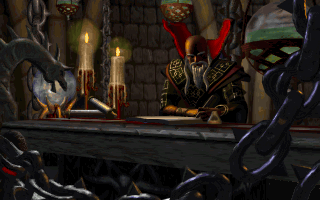
Themedes, (not so) Sage of Mur, writing the Chronicles of Deeds
This notably applies to a very selective and narrow vision of Thyrion, considering only the four great powers of Blackmarsh, Mazaera, Thysis and Septimus. Although indisputably being the most powerful civilizations (hence Eidolon sending his dark generals there in priority), they are far from being the only existing ones. Just like our world, Thyrion features a far greater diversity of places, customs and architectures.
Pretending that Tulku suddenly appeared as if by magic after Eidolon's defeat is of course an immeasurable absurdity only proving the lack of geographical knowledge of whoever issued such a non-sense. Quite the opposite, it is a good example of a very ancient country having a long history of science, culture and philosophy. Its lavish and impressive temples show it enough.
But it's not the only example, and other very unique countries are waiting to be discovered and explored...
Wheel Of Karma will feature three of them in its third installment whose release shouldn't occur before the mid 2020s.
This page presents them far in advance to allow anyone to imagine their own vision of them and build maps taking place in the extended universe proposed here.
General considerations
As a proposition for a shared extended universe for which everybody is welcome to map, none of the guidelines and recommendations expressed here are obligations. They are not meant to be strictly followed, but rather meant to provide inspiration.Due to the primary source being Wheel Of Karma, I would of course be happy to provide support, exchange of views, entities you may have seen in action in WOK and would like to use in your own maps, etc.
WOK frequently using Quake's sundagger pattern, it can be safely used as a consistent element of the Karmaverse.

Agawara
* Real life basis *
Agawara is inspired by medieval Japan. The main reference place used by WOK is the Katsura Imperial Villa hence the strong focus on it in the following.But feel free to choose any other place or element grounded in the old traditional Japan: it's good as well ! (even if the rules described below don't necessarily apply anymore).
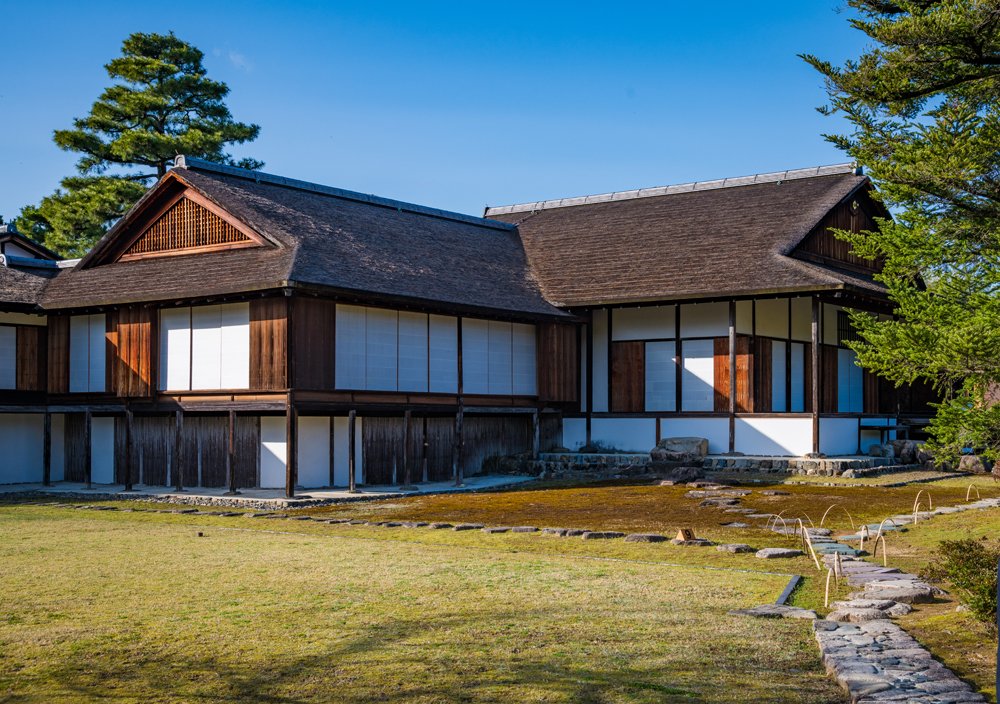
Katsura Imperial Villa
* Aesthetics *
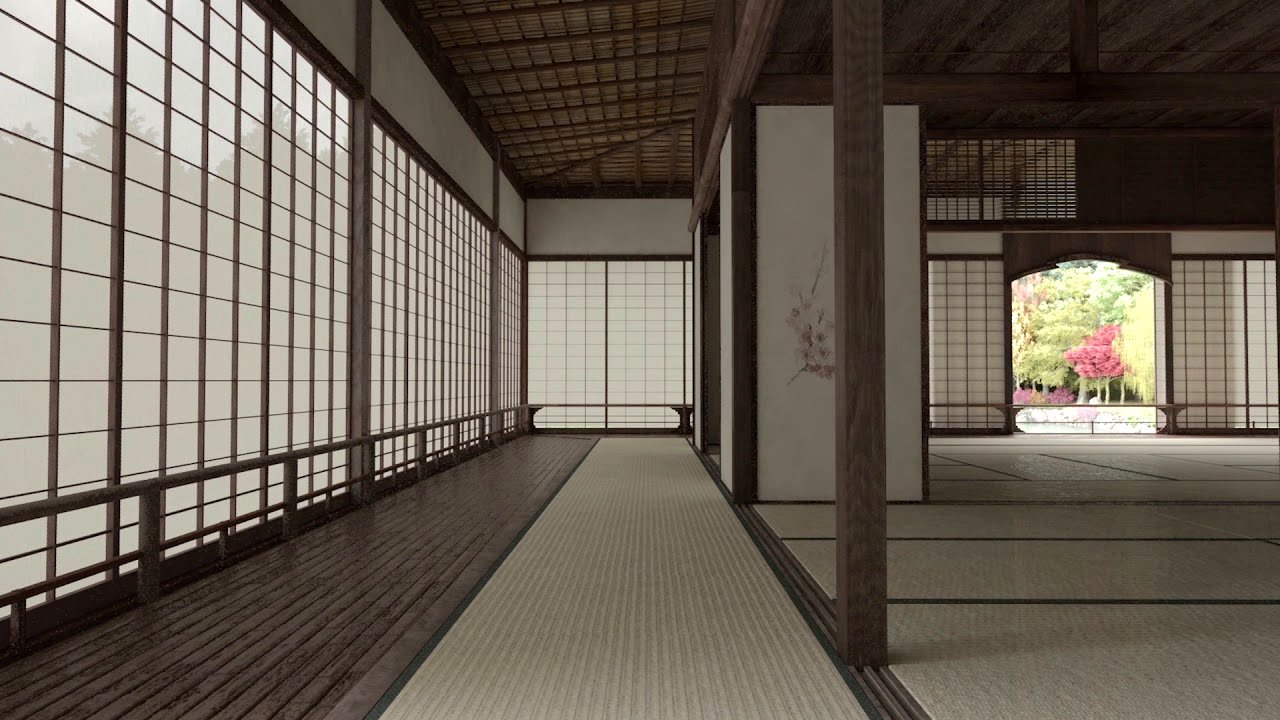
It's a very light and delicate architecture implying a lot of wooden strips, beams, piles, rods, etc. strongly contrasting with white paper walls. It makes for very graphic almost black & white rooms with horizontals, verticals and grid patterns.
Occasional highlights are all the more noticeable and help the player's orientation. Walls with traditional Japanese landscapes, sceneries or patterns (waves, paulownia, etc.) are a good option.
Relevant elements one may find in Agawara:
- Panels with ink calligraphy
- Tatami floors
- Red paper lanterns
- Zen rock gardens
- Small shoji-like windows above doors
- Stone lanterns
- Stepping stones
- ponds & fountains
- Bamboo in outdoors
- Tokonoma
- Chigaidana
- Etc.
* Map design and gameplay *
Because of the lightweight architecture, walls are very specific:- They use to be made of wood and paper or wood and fabric.
- They are thin.
- They are more likely to be breakable.
- They may slide.
Buildings are not high. They tend to be on the same level and offer poor verticality. Instead they spread as a labyrinth of rooms tending to look pretty much alike except for occasional details, much to the player's disorientation. Having walls sliding or breaking is susceptible to suddenly unveil unsuspected dangers, all the more that the player lack long lines of sight indoors to see things in advance. The windows are not so many and don't tend to be regular openings, but instead not-see-through paper windows just letting a smooth light come in.

The convoluted layout of real-life Katsura
(Click on the picture to get to a gallery of useful and inpirational views of Katsura)
The rooms are especially prone to hiding dangers and secret closets. Because everything tends to be at eye level, the player may fail at paying attention to the ceilings and beams over their head and miss clues or hazards.
The design is overall very compartmentalized which reinforces the maze-like feeling. The outdoors are inner courtyards with a garden, a pond, etc. surrounded by galleries on piles. But they don't help figuring out the general map layout and boundaries.
* Monsters *
Because of many relatively narrow indoors, melee monsters may be more common than usually. The amount of mana pickups might be reduced to encourage melee fight with weapon #1.The premises are notably haunted by "samurai golems" with distinctive helmets, a very endemic monster found only in Agawara.
Qazzarith
* Real life basis *
Qazzarith is based on the Persian/Arabic world, which is pretty vague and allows for a lot of freedom for mapping and finding ideas.WOK implementation will focus more specifically on Uzbek architecture, so the guidelines below go a bit more in that direction. But once again, that's only one take among dozens possible.
* Aesthetics *
Basically, what is sure is that Qazzarith is an arid place standing in the middle of the hot sandy desert. The architecture tends to offer a sensible contrast between "in" and "out". From the outside the buildings are pretty massive; the walls look thick, made of big brown stone offering a protection again the heat, against the sand storms... and against curiosity! People enjoy their privacy. But once your enter, you may discover far more elaborated palace architectures with columns, mosaïcs, inner courtyards surrounded by covered galleries offering shadows against the sunlight, fountains maybe...Because of the desert, the vegetation in scarce and people imagine the Heaven like a fresh garden, hence owning a private pond is a visible sign of wealth.
Qazzarith is a land of scholars known for their spirituality, libraries and skills in sciences like mathematics or astronomy. They enjoy food, perfumes and refined arts including patterns, mosaics and calligraphy which are very elaborated but always abstract, never representationalist.
People don't use chairs and rather sit down on carpets, which are therefore pretty common in interiors.
Being the color of water and clear sky, the color blue is especially appreciated in Qazzarith and widely used for majestic pieces, notably mosaics or cupolas.
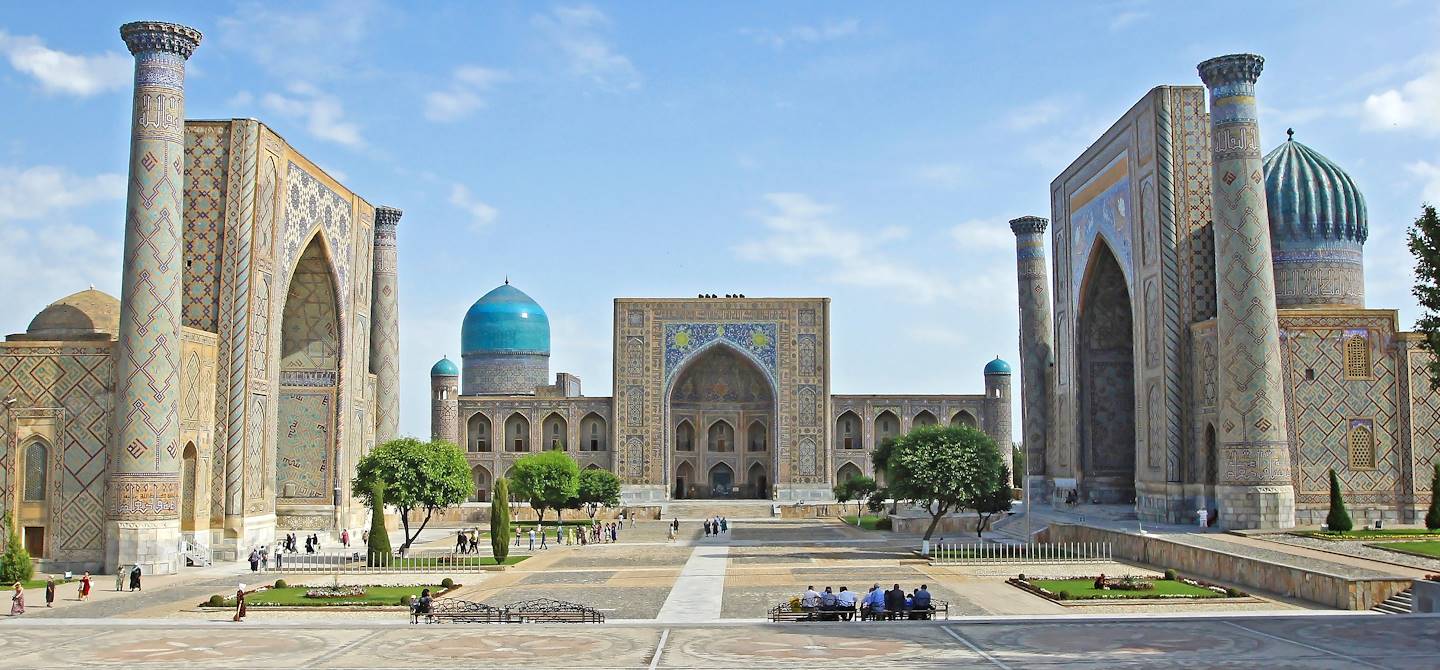
The Registan Square in Samarkand (Uzbekistan) offers a typical example of what Qazzarith may look like.
Textures from the vanilla Thysis Egyptian hub can be reused (ashlar wall textures...) as well as some textures found in Heretic II. WhirledTsar also shares the working texture pack for their 2022 map Qazzarith Library. Although being a Quake project, Simon "Sock" O'Callaghan's impressive One Thousand Cuts map also offers a valuable source of nice textures (and inspiration, due to its very Qazzarithian feel!).
Of course it's just a proposed starter kit: thousands of relevant textures may be found all over the internet!
Click on the icon to download the corresponding texture pack.
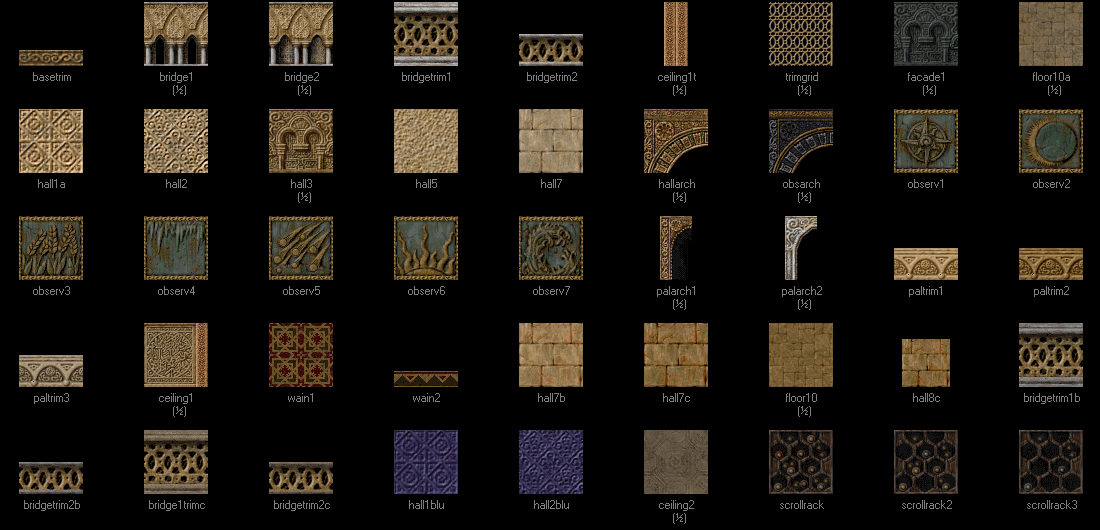
Relevant Heretic II textures (Click on the picture to enlarge)
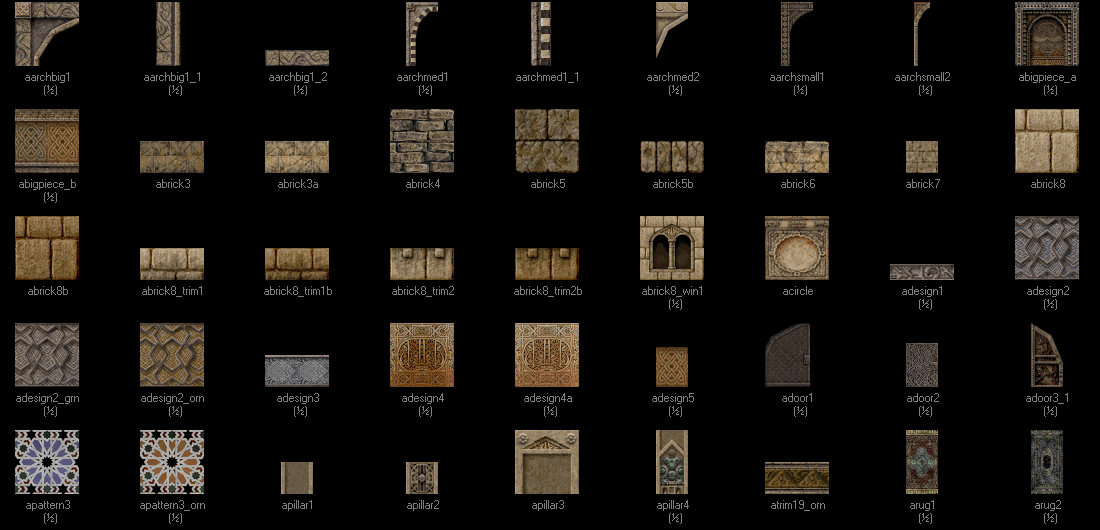
Qazzarith Library textures (Click on the picture to enlarge)

One Thousand Cuts textures (Click on the picture to enlarge)
* Map design and gameplay *
Cities in Qazzarith are built like fortresses.Fortresses against the elemental forces of Nature, to start with. Even if the interiors might be elaborated, the general structure of buildings remains mostly massive. So unless you really venture in the desert, you won't see the landscape a lot and the outdoors will mainly consist in courtyards and large square plazas surrounded by high thick walls.
But also fortresses against the pillagers from the desert. So it's pretty common to see war machines built by Qazzarith scientists. Expect to see ballistas or catapults.
* Monsters *
The type of monsters encountered in Qazzarith is similar to those in Thysis, the surrounding ecosystem being very close. Local means of transportation include curiosities rarely seen anywhere else in Thyrion like camels... or even stranger things...But the main threat is of course the deadly Shadow Wizards who are here at home.
Babalpor
* Real life basis *
Babalpor is based on the Mesopotamian civilizations, especially Babylon.* Aesthetics *
Being a place in the desert, Babalpor shares similarities with Thysis and Qazzarith, notably a heavy brownish architecture, but unlike the former it stands in a region irrigated with big rivers. Here the brown settings are not temperate by the color blue but by the color green, thanks to the presence of vegetation. Babalpor is known indeed for its oases and the marvel of its Hanging Gardens.Like in Qazzarith, mosaics are appreciated, and bas-reliefs too. But here they are willingly representationalist, depicting animals, vegetation, soldiers, etc.
Indeed Babalpor people are not esthetes or scholars but pretty earth grounded people. Their approach to science and techniques is not intellectualized but very pragmatic instead. They are a nation of warriors and growers.
They are also skilled builders and craftsmen: mechanisms/mobile parts usually spice up their often massive and simple architecture. Crenelated walls, friezes and round archways/windows are common too.

The Ishtar Gate of Babylon is a typical scenery one could see in Babalpor.
Textures from the vanilla Thysis Egyptian hub may be reused here too (ashlar wall textures...) but even better, thanks to WhirledTsar we have a very nice Babylon texture set available, coming straight from the Indiana Jones & The Infernal Machine game.
Once again it's of course just a proposed starter kit: many other relevant textures may be found all over the internet.
Click on the icon to download the texture pack.

Indiana Jones & The Infernal Machine's Babylonian textures (Click on the picture to enlarge)
* Map design and gameplay *
Like in Qazzarith, Babalpor cities look like fortresses but they feel more like a southern version of Blackmarsh because they also offer small streets where regular people live, bazaars, small shops, etc. They are not prestige architecture only, and even the most prestigious buildings keep being relatively simple. No fancy cupolas and towers like in Qazzarith, unless in form of ziggurats. Here the luxury is rather expressed by abundant gardens, water pieces and stepwise terraces. With such a focus on outdoors, expect largely open air maps.Being very skilled engineers, Babalporians specialized in fast transportation not by means of magic (teleporters are a rarity) but of technology: elevators, moving platforms, popular wind tunnels and even low gravity fields allowing to quickly jump from one floor to the next!
It allows for fast moving gameplay and use of verticality, which is fortunate since flying imps are a common chore!
* Monsters *
For some reason it seems that more than anything else Babalpor plazas attract lesser monsters chasing you in packs or swarms. Isolate monsters are not so common and mostly come as sniper archers shooting at you from incredible distances, hidden behind the crenelations. Moving constantly is a requirement to survive!
 Inky's Hexen II Mapping Corner...
Inky's Hexen II Mapping Corner...

 KDM Textures by Kell
KDM Textures by Kell